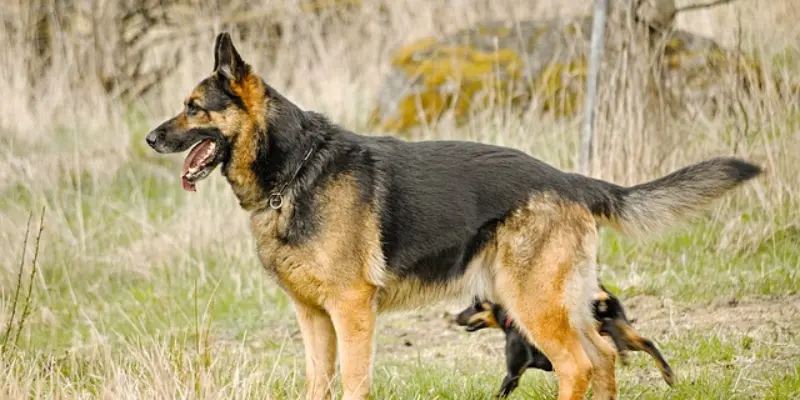The Giant German Shepherd Breed Profile: A Guide to Size, Health & Temperament
Updated: August 10, 2024
61
The giant German Shepherd breed stands out among its canine counterparts for its impressive size and noble appearance. These dogs embody strength and loyalty, also known as King German Shepherds or Oversized German Shepherds. Let’s delve into what makes them unique and why they’re beloved by many.
Characteristics of the Giant German Shepherd Breed
Physical Attributes of Giant German Shepherd
Giant German Shepherds are notably larger than the standard variety. They typically weigh between 90 to 150 pounds and stand around 26 to 30 inches tall at the shoulder. Their coats come in various colors, including black and tan, ebony, and solid black, with distinctive markings that highlight their robust build.

Temperament and Personality Traits
Known for their intelligence and protective instincts, giant German Shepherds make excellent guard dogs and loyal companions. They are confident, courageous, and quick learners, making them ideal for various roles, including search and rescue, police work, and service dogs. Their gentle demeanor with family members contrasts with their alertness towards strangers, showcasing their versatile nature.
Giant German Shepherd Exercise and Training Needs
Due to their size and energy levels, giant German Shepherds require regular exercise and mental stimulation. Daily walks, playtime, and training sessions are essential to keep them physically fit and mentally engaged. Positive reinforcement techniques work best for their sensitive nature, ensuring they develop into well-rounded, obedient companions.
Special Properties of Giant German Shepherd Breed
| Property | Description |
|---|---|
| Size | Larger than standard German Shepherds, with males reaching up to 30 inches in height and weighing up to 120 pounds |
| Coat | Double coat, with a thick undercoat and a durable outer coat that sheds heavily |
| Intelligence | Highly intelligent, ranking among the top 3 most intelligent breeds |
| Loyalty | Extremely loyal and protective of family, but can be wary of strangers |
| Energy Level | High energy, requiring regular exercise and mental stimulation |
| Health | Prone to hip dysplasia, elbow dysplasia, and digestive issues due to rapid growth rate |
| Trainability | Highly trainable, but requires early socialization and consistent training |
| Life Expectancy | 10-13 years, with proper care and nutrition |
| Grooming Needs | High maintenance, requiring regular brushing and grooming to prevent matting |
| Family Suitability | Suitable for active families with children, but may be too boisterous for small pets or inexperienced owners |
History of the Giant German Shepherd Breed
Origins of the German Shepherd Breed
The German Shepherd breed originated in Germany in the late 19th century. Initially bred for herding sheep, it was standardized by Captain Max von Stephanitz, who emphasized its intelligence, athleticism, and loyalty.
Development of the Giant Breed Variation
Over time, breeders selectively bred larger German Shepherds, resulting in the development of the giant variation. These dogs maintained the breed’s traditional traits while adding substantial size, catering to specific preferences for larger working and companion dogs.
Popular Giant German Shepherd Breeders
Several reputable breeders specialize in producing quality giant German Shepherds, focusing on health, temperament, and adherence to breed standards. Researching and choosing a responsible breeder ensures acquiring a well-adjusted puppy with a sound genetic background.
Care and Maintenance of a Giant German Shepherd Puppy
Giant German Shepherd Puppy Feeding Requirements
During the puppy stage, giant German Shepherds require a balanced diet rich in protein and nutrients to support their rapid growth. Regular feeding schedules and appropriate portion sizes are crucial to prevent overfeeding and potential skeletal issues associated with rapid growth.

Exercise and Socialization Needs of Giant German Shepherd Puppy
Early socialization and exposure to various environments help giant German Shepherd puppies develop into confident adults. Structured playtime and interaction with other dogs and people foster positive behavior and reduce the risk of anxiety or aggression later in life.
Grooming Tips German Shepherd Puppy
Their double coat requires regular brushing to minimize shedding and maintain coat health. Bathing should be done as needed using a mild dog shampoo to preserve their natural oils. Routine grooming also includes nail trimming, ear cleaning, and dental care to ensure overall well-being.
Health Issues Commonly Seen in Giant German Shepherds
- Potential Health Problems
While generally healthy, giant German Shepherds are prone to certain genetic conditions, such as hip and elbow dysplasia and bloat. Responsible breeding practices and regular veterinary check-ups are essential for early detection and management of these issues.
- Preventative Measures
Proper diet and exercise can help dogs maintain a healthy weight and reduce the risk of joint problems. Monitoring their activity levels and avoiding strenuous exercise after meals can help prevent bloat, a potentially life-threatening condition requiring immediate veterinary attention.
Importance of Regular Vet Check-ups
Annual veterinary visits, vaccinations, and preventive care screenings are vital for monitoring their health and addressing any concerns promptly. Early intervention can significantly impact their quality of life and longevity.
Famous Giant German Shepherds
Notable Examples
Famous giant German Shepherds have left their mark in popular culture and history. From heroic search and rescue dogs to beloved movie stars, their contributions and captivating stories continue to inspire admiration and respect worldwide.
Eagle Pack Large & Giant Breed Puppy Food for German Shepherds
Eagle Pack Large & Giant Breed Puppy Food is a nutrient-rich diet specifically formulated for large and giant breed puppies like German Shepherds. This food is designed to support healthy growth and development, while also addressing the unique needs of larger breeds.
Key Features:
| Feature | Description |
|---|---|
| High-Quality Protein | Chicken meal and lamb meal for muscle growth and development |
| Joint Support | Glucosamine and chondroitin for healthy joints and hips |
| Digestive Health | Fiber and probiotics for healthy digestion and bowel movements |
| Antioxidants | Vitamin E and beta-carotene for immune system support |
| No Fillers | No corn, wheat, or soy fillers to ensure optimal nutrition |
| Growth Rate | Formulated to support a slow and steady growth rate for large breeds |
| Age Range | Suitable for puppies up to 12-18 months old |
Conclusion
In conclusion, the giant German Shepherd breed offers a unique blend of size, intelligence, and loyalty, making them exceptional companions and working dogs. Prospective owners considering this majestic breed should prioritize thorough research, responsible breeding practices, and commitment to their care and well-being.
For those interested in welcoming a giant German Shepherd into their home, reputable breeders who prioritize health and temperament are essential. Resources such as national breed clubs and online forums can provide valuable guidance and connections to reputable sources.
FAQs
What is a giant German Shepherd breed?
The giant German Shepherd breed is a larger-than-average variation of the traditional German Shepherd dog, known for their impressive size and strength.
Where can I find a giant German Shepherd breed puppy for adoption?
You can find giant breed German Shepherd puppies for adoption from reputable breeders or rescue organizations that specialize in larger breeds.
What is the name of the giant German Shepherd breed?
The giant German Shepherd breed is often referred to as a “giant German Shepherd” due to their larger size compared to standard German Shepherds.
Are Giant German Shepherds good family pets?
Yes, Giant German Shepherds are known for being great family pets due to their loyal and protective nature, as well as their gentle temperament.
Are giant German Shepherds similar to the eagle black large breed?
While the eagle black large breed may share some physical similarities with giant German Shepherds, they are likely two different breeds with distinct characteristics. It’s important to research each breed individually to understand their differences.
Please Write Your Comments